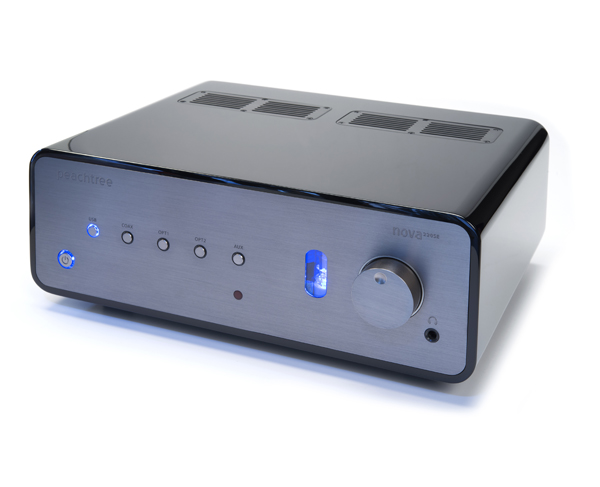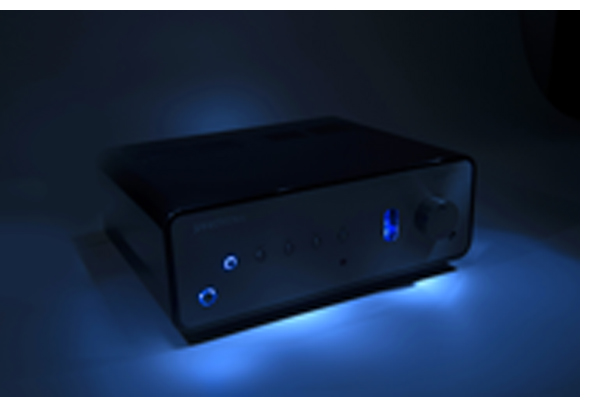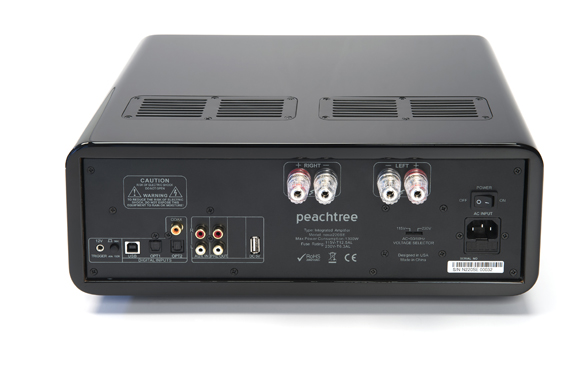Peachtree nova220SE Integrated Amplifier
By Mark Marcantonio The idea of an integrated amplifier has always appealed to me. Combining the amplifier and preamplifier sections in a properly isolated design makes economic sense—just sit back and enjoy the music without the bleed-through of a tuner.
The idea of an integrated amplifier has always appealed to me. Combining the amplifier and preamplifier sections in a properly isolated design makes economic sense—just sit back and enjoy the music without the bleed-through of a tuner.
Last year, I had the pleasure of reviewing Peachtree’s nova125 integrated and, while I enjoyed both its form and function, I wondered what impact nearly doubling its power would have on the notoriously power-hungry Magnepan 1.6 speakers. Well, I now know—and it’s been worth the wait. The nova220SE possesses tremendous grip, never letting the Magnepans beat it into submission.
Delving into orchestral music with Beethoven’s 9th by the North German Radio Symphony conducted by Günter Wand, I experience the symphony’s beautiful, complex inner movements and quick pace changes, which prove a great test for the nova. Where lesser-quality amplifiers struggle to keep instrument separation, the nova performs exceedingly well. Even under the intensity of the Magnepan’s 2-ohm load drops and volume levels crossing 100 dB, the amp stays in control. It revels in being driven hard; this isn’t an integrated for those who enjoy listening to music at whisper levels.
Nuts and Bolts
The nova continues Peachtree’s distinctive and curvaceous design. The various stained-wood cases have been replaced by black lacquer, and the front panel is brushed aluminum, with a similar gray color to that of Kyocera equipment from the 1980s.
The nova’s front panel is clean, though I do wish the selector buttons were identified with a slightly larger font, as the contrast on the panel is minimal. The power button is located in the lower left, with the five source buttons—USB, coax, opt 1, opt 2, and analog—encircled by blue LEDs. Following the Peachtree tradition, a blue LED-lit oval window displays the nova’s Russian-made 6N1P tube. A large, smoothly rotating volume knob completes the front panel. The back panel is nearly as clean: wired remote and source inputs, jacks for pre-out and RCA, right and left speaker binding posts, power cord receptacle, and master power switch. The amp is 14.8 inches wide, 5.2 inches tall, and 11.5 inches deep, and it weighs just over 19 pounds.
The matching anodized-aluminum front remote is also straightforward, with two groupings of buttons; the upper for controlling volume and tube buffer and selecting the USB input, and the lower for selecting the other four inputs.
As I go through my various test tracks, the toms on the drum kit really stand out. The nova makes the various hits pop with intensity. Whether reproducing the attacks of the Who’s wild man Keith Moon or the magic of Buddy Rich, the exact placement of the drumsticks on the toms is distinct and easily discernable. Chalk that up to the class-A preamp section and the 220/350 watts per channel (into 8 and 4 ohms, respectively) of the class-D power section. The clarity between the left and right hits on Dan Fogelberg’s “Higher Ground” has me replaying the track several times over.
Until recently, praising class-D power amplifiers came with a warning that proper speaker matching is crucial. Just like Peachtree’s nova125, the nova220SE needs no such disclaimer. With speakers from Harbeth, Totem, ACI, Golden Ear, and Magnepan, this integrated amplifier shows no weaknesses—though the combination with the Golden Ear Triton Sevens is a particularly good match, both sonically and financially. Just one listen to “Still… You Turn Me On” by Emerson, Lake and Palmer convinces me to keep the amp-speaker combo together for a week.

A Lot to Love
To the team at Peachtree, the word integrated means including a built-in DAC that utilizes the asynchronous ESS Sabre Hyperstream 9022 chip, USB and coax inputs that can handle resolutions ranging from 16 bits/44 kHz all the way to 24/192, and two optical inputs (which are limited to 24/92). Using my MacBook running iTunes/Pure Music and a Wadia i170 iPod dock, I’m able to test all the configurations. The DAC section is a fine performer—definitely not a gimmick. I find it bettering the Audioengine D2 DAC by pulling out greater inner detail, which is especially noticeable in the guitar and piano of William Ackerman’s “Climbing in Geometry.” On the same song through my reference Simaudio 300D DAC, the edges of the highest frequencies come out a hair shriller than through the nova, and the acoustic guitar is a bit drier—but overall the nova puts forth an impressive effort.
Since my wife works from home, I spend a great deal of time using the nova’s headphone output, which offers 1,170 mW into 32 ohms and really brings a pair of Sennheiser HD800s to life. Bonnie Raitt’s mellow masterpiece “Nick of Time” holds the same acoustic properties as when running through speakers, signaling that the headphone section wasn’t an afterthought but a well-thought-out part of the nova220SE. For those readers who wonder if the headphone output gets the tube buffer treatment, the answer is yes and it offers the same tubey goodness as the amplifier does.
When listening to the nova through speakers, I keep the tube buffer engaged for the most part, as I’m a fan of the harmonic pleasure that vacuum tubes provide. But at times it’s hard to tell when the 6N1P tube is in the auditory loop, which I attribute to the superb class-A preamplifier section. Consider the tube buffer as a tone control for the 21st century.
When nothing but heavy metal will suffice, the nova, like a Detroit muscle car, is ready to go balls to the walls at anytime. “I Can’t Quit You Baby” from Led Zeppelin’s BBC Sessions alternates between stoplight blues and accelerating guitar riffs. The sheer grunt to put the listener back in his or her seat is the nova220SE’s specialty. Get comfortable and enjoy the sonic ride.
Obvious differences between the $1,999 nova220SE and my reference $8,000 Simaudio Moon i-7 integrated are subtle but prevalent. The little things are missing from the nova’s resolution. For example, the xylophone notes at the beginning of Steely Dan’s classic “Aja” don’t take on the three-dimensionality that I’m used to hearing. Steve Martin’s exceptional banjo picking through the nova occasionally sounds a bit flat when measured against the i-7. But beyond that, the nova is a very worthy competitor.
For the digital junkie, the nova’s myriad inputs enable CD playback, mass storage, and streaming from multiple sources without swapping wires—just push a button and jump from a hard drive to AirPlay or Sonos. Vinyl lovers only need to plug their favorite phono preamp into the nova’s auxiliary input to enjoy their favorite records. For those with budgetary concerns, the low energy usage of the nova’s class-D power section and its versatile preamp section, along with Peachtree’s two-year warranty, make it a wallet-friendly investment.

Final Tally
As smitten as I was with the nova125 last year, I’m totally impressed with the nova220SE. With nearly twice the power and an improved preamp design trickled down from Peachtree’s top-of-the-line X-1 integrated, it makes terrific music with every speaker combo I have on hand. Right now, if I were forced to change integrated amplifiers, the nova220SE would be my choice. The sheer value of its capabilities as an integrated amp, DAC, and headphone amplifier makes the nova220SE a no-brainer. The only thing keeping it from being perfect is its lack of a built-in phono preamp. Perhaps Peachtree will incorporate one into the next iteration.
nova220SE Integrated Amplifier
MSRP: $1,999
PERIPHERALS
| Amplifiers | SimAudio Moon i7 integrated amplifier Vista Audio i35 integrated tube amplifier Virtue Audio Sensation M451 Tripath/hybrid integrated amplifier |
| Phonostage | Simaudio Moon LP5.3 |
| Sources | Rega RP1 turntable with Ortofon Super OM40 cartridge MacBook iTunes/PureMusic Wadia i170 w/iPod 160 Classic |
| Digital Processor | SimAudio Moon 300D |
| Speakers | ACI Emerald XL Harbeth Compact 7ES3 Golden Ear Triton Seven Magnepan 1.6 with Skiing Ninja crossovers Totem Acoustic Rainmakers |
| Cables | Shunyata Venom 3 power cord AudioArt IC-3 interconnects AudioArt SC-5 speaker cables |


